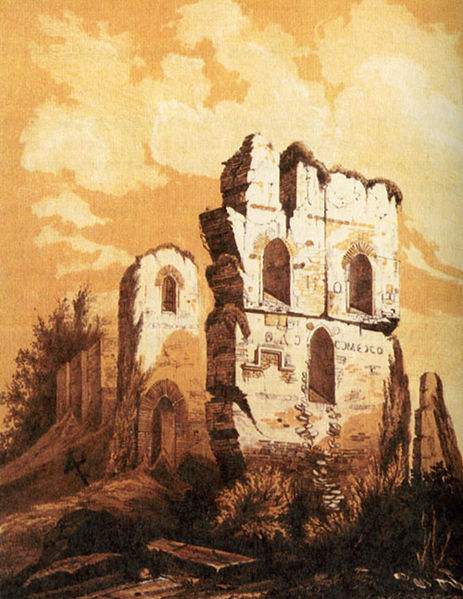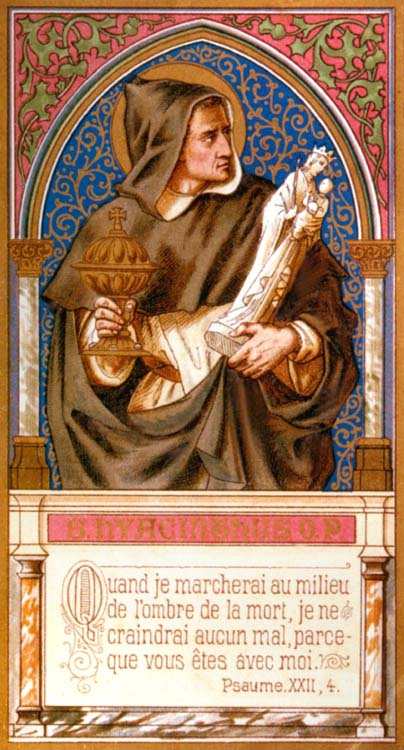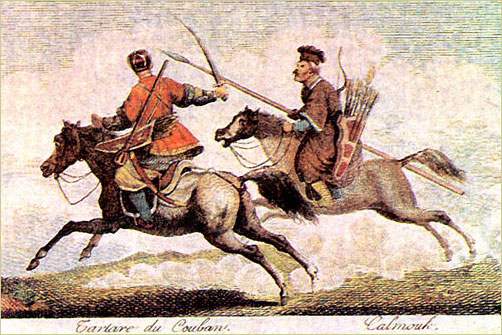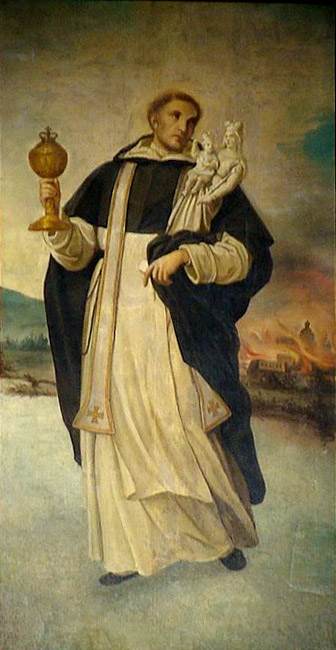
Church of the Dormition of the Virgin (also called Church of the Tithes) in ruins. It was the first stone Church in Kiev. The church was ruined during the siege of Kiev by Tartar armies of Batu Khan in 1240. Grand Prince Vladimir (Volodymyr) the Great, set aside a tithe of his income and property to finance the church’s construction and maintenance, which gave the church its popular name. The church was rebuilt in the mid 19th century, but in 1928 it was once again destroyed by the Soviet regime.
St. Hyacinth had just completed a magnificent church at Kiev, in Poland, which he dedicated to the Most Holy Mother of God. One day as he had just finished the celebration of Holy Mass, it was announced to him that the Tartars, the most implacable enemies of the Christian name, had reached the walls of the town, and were endeavoring to force an entrance. The Saint was much surprised at this information, but he did not allow himself to be disturbed. He feared less the ruin of the city and the church than the outrages without number which these barbarians would inflict on the innocent people, and the sacrileges they would commit against holy things, especially the Most Holy Sacrament of the altar.
Full of confidence in God, he reverently opened the tabernacle, and, taking out the ciborium, he concealed it under his tunic near his heart; then, turning towards the religious who were standing around him trembling with fear, he said to them: “Follow me, my brethren, and be not afraid.”
 But when he came near the door of the church he heard a loud voice which cried out: “Hyacinth, Hyacinth!” He stood and looked all around, but could see no one, so he turned to continue on his way. Immediately he heard the same voice again saying the same words. Once more he looked behind him, and, to his great astonishment and that of all those who accompanied him, he perceived that it proceeded from the statue of Our Lady, which was placed on an altar near the center of the church. It was made of alabaster, and exceedingly heavy.
But when he came near the door of the church he heard a loud voice which cried out: “Hyacinth, Hyacinth!” He stood and looked all around, but could see no one, so he turned to continue on his way. Immediately he heard the same voice again saying the same words. Once more he looked behind him, and, to his great astonishment and that of all those who accompanied him, he perceived that it proceeded from the statue of Our Lady, which was placed on an altar near the center of the church. It was made of alabaster, and exceedingly heavy.
“My beloved Hyacinth,” the voice added,” is it thus you are about to deliver my Son from the hands of the barbarians, and to leave His Mother to their impious insults?”
As the Saint answered that it was impossible for him who was so weak to carry a burden which was so heavy, the voice replied: “If you had a little more faith and a little more love for me, it would be very easy for you to carry it.”
“I desire nothing so much as to possess that love and confidence replied St. Hyacinth. “See, I am ready to obey at once.”
Saying these words, he approached the altar of Our Lady, and with loving respect, stretching out his arms, he placed the statue upon them, and carried it as easily as if it had been a little flower.
It was thus that he left the village, the image of Our Lady in his arms and the holy ciborium on his breast, accompanied by his brethren. He passed unmolested through the ranks of the enemy, who, by the permission of God, stood at a distance, and whose eyes were struck with blindness for a time so that they could not see them.
 When they had passed out of the village, they directed their steps towards the city of Cracovia. Here another miracle occurred to console them on their journey. When they reached the banks of the river over which they had to pass, they could find no means of reaching the other side. But full of confidence in the power of the Most Holy Sacrament which he held in one hand, and in the protection of Mary, whose image he carried in the other, he made the sign of the Cross; then, placing his feet on the surface of the waters, he reached the opposite bank without even moistening the soles of his sandals.
When they had passed out of the village, they directed their steps towards the city of Cracovia. Here another miracle occurred to console them on their journey. When they reached the banks of the river over which they had to pass, they could find no means of reaching the other side. But full of confidence in the power of the Most Holy Sacrament which he held in one hand, and in the protection of Mary, whose image he carried in the other, he made the sign of the Cross; then, placing his feet on the surface of the waters, he reached the opposite bank without even moistening the soles of his sandals.
The religious who were along with him, seeing repeated the miracle of St. Peter walking on the waters, followed him and also reached the other side of the river, the water not appearing even to touch them.
Another miracle still more marvelous is recorded in the process of the canonization of the Saint.
The river over which they thus miraculously passed for a considerable time afterwards continued to show the impression of the Saint’s footsteps.
When St. Hyacinth reached Cracovia, he placed the ciborium on the high altar of the church, and the statue of Our Lady on one of the side altars. Many other wonderful things are recorded to have taken place there through the intercession of Our Lady, which caused many of the people to embrace the true Faith and strengthened and vivified the life of faith in the souls of those who already possessed it.
The Catechism in Examples Vol. 5, Pg. 60-63 by Rev. D. Chisholm
Short Stories on Honor, Chivalry, and the World of Nobility—no. 441








